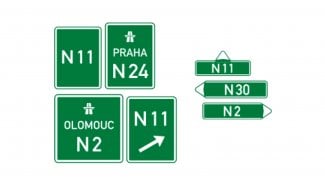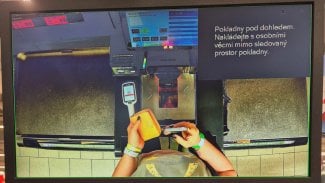ctgsja
NAME
CTGSJA - compute the generalized singular value decomposition (GSVD) of two complex upper triangular (or trapezoidal) matrices A and B
SYNOPSIS
SUBROUTINE CTGSJA(
JOBU, JOBV, JOBQ, M, P, N, K, L, A, LDA, B,
LDB, TOLA, TOLB, ALPHA, BETA, U, LDU, V, LDV,
Q, LDQ, WORK, NCYCLE, INFO )
CHARACTER
JOBQ, JOBU, JOBV
INTEGER
INFO, K, L, LDA, LDB, LDQ, LDU, LDV, M, N,
NCYCLE, P
REAL
TOLA, TOLB
REAL
ALPHA( * ), BETA( * )
COMPLEX
A( LDA, * ), B( LDB, * ), Q( LDQ, * ),
U( LDU, * ), V( LDV, * ), WORK( * )
PURPOSE
CTGSJA computes the generalized singular value decomposition (GSVD) of two complex upper triangular (or trapezoidal) matrices A and B.
On entry, it is assumed that matrices A and B have the following
forms, which may be obtained by the preprocessing subroutine CGGSVP
from a general M-by-N matrix A and P-by-N matrix B:
N-K-L K L
A = K ( 0 A12 A13 ) if M-K-L >= 0;
L ( 0 0 A23 )
M-K-L ( 0 0 0 )
N-K-L K L
A = K ( 0 A12 A13 ) if M-K-L < 0;
M-K ( 0 0 A23 )
N-K-L K L
B = L ( 0 0 B13 )
P-L ( 0 0 0 )
where the K-by-K matrix A12 and L-by-L matrix B13 are nonsingular upper triangular; A23 is L-by-L upper triangular if M-K-L >= 0, otherwise A23 is (M-K)-by-L upper trapezoidal.
On exit,
U'*A*Q = D1*( 0 R ), V'*B*Q = D2*( 0 R ),
where U, V and Q are unitary matrices, Z' denotes the conjugate transpose of Z, R is a nonsingular upper triangular matrix, and D1 and D2 are ``diagonal'' matrices, which are of the following structures:
If M-K-L >= 0,
K L
D1 = K ( I 0 )
L ( 0 C )
M-K-L ( 0 0 )
K L
D2 = L ( 0 S )
P-L ( 0 0 )
N-K-L K L
( 0 R ) = K ( 0 R11 R12 ) K
L ( 0 0 R22 ) L
where
C = diag( ALPHA(K+1), ... , ALPHA(K+L) ),
S = diag( BETA(K+1), ... , BETA(K+L) ),
C**2 + S**2 = I.
R is stored in A(1:K+L,N-K-L+1:N) on exit.
If M-K-L < 0,
K M-K K+L-M
D1 = K ( I 0 0 )
M-K ( 0 C 0 )
K M-K K+L-M
D2 = M-K ( 0 S 0 )
K+L-M ( 0 0 I )
P-L ( 0 0 0 )
N-K-L K M-K K+L-M
M-K ( 0 0 R22 R23 )
K+L-M ( 0 0 0 R33 )
where
C = diag( ALPHA(K+1), ... , ALPHA(M) ),
S = diag( BETA(K+1), ... , BETA(M) ),
C**2 + S**2 = I.
R = ( R11 R12 R13 ) is stored in A(1:M, N-K-L+1:N) and R33 is stored ( 0 R22 R23 )
in B(M-K+1:L,N+M-K-L+1:N) on exit.
The computation of the unitary transformation matrices U, V or Q is optional. These matrices may either be formed explicitly, or they may be postmultiplied into input matrices U1, V1, or Q1.
N-K-L K L
A = K ( 0 A12 A13 ) if M-K-L >= 0;
L ( 0 0 A23 )
M-K-L ( 0 0 0 )
N-K-L K L
A = K ( 0 A12 A13 ) if M-K-L < 0;
M-K ( 0 0 A23 )
N-K-L K L
B = L ( 0 0 B13 )
P-L ( 0 0 0 )
where the K-by-K matrix A12 and L-by-L matrix B13 are nonsingular upper triangular; A23 is L-by-L upper triangular if M-K-L >= 0, otherwise A23 is (M-K)-by-L upper trapezoidal.
On exit,
U'*A*Q = D1*( 0 R ), V'*B*Q = D2*( 0 R ),
where U, V and Q are unitary matrices, Z' denotes the conjugate transpose of Z, R is a nonsingular upper triangular matrix, and D1 and D2 are ``diagonal'' matrices, which are of the following structures:
If M-K-L >= 0,
K L
D1 = K ( I 0 )
L ( 0 C )
M-K-L ( 0 0 )
K L
D2 = L ( 0 S )
P-L ( 0 0 )
N-K-L K L
( 0 R ) = K ( 0 R11 R12 ) K
L ( 0 0 R22 ) L
where
C = diag( ALPHA(K+1), ... , ALPHA(K+L) ),
S = diag( BETA(K+1), ... , BETA(K+L) ),
C**2 + S**2 = I.
R is stored in A(1:K+L,N-K-L+1:N) on exit.
If M-K-L < 0,
K M-K K+L-M
D1 = K ( I 0 0 )
M-K ( 0 C 0 )
K M-K K+L-M
D2 = M-K ( 0 S 0 )
K+L-M ( 0 0 I )
P-L ( 0 0 0 )
N-K-L K M-K K+L-M
M-K ( 0 0 R22 R23 )
K+L-M ( 0 0 0 R33 )
where
C = diag( ALPHA(K+1), ... , ALPHA(M) ),
S = diag( BETA(K+1), ... , BETA(M) ),
C**2 + S**2 = I.
R = ( R11 R12 R13 ) is stored in A(1:M, N-K-L+1:N) and R33 is stored ( 0 R22 R23 )
in B(M-K+1:L,N+M-K-L+1:N) on exit.
The computation of the unitary transformation matrices U, V or Q is optional. These matrices may either be formed explicitly, or they may be postmultiplied into input matrices U1, V1, or Q1.
ARGUMENTS
JOBU (input) CHARACTER*1
= 'U': U must contain a unitary matrix U1 on entry, and
the product U1*U is returned;
= 'I': U is initialized to the unit matrix, and the
unitary matrix U is returned;
= 'N': U is not computed.
JOBV (input) CHARACTER*1
= 'V': V must contain a unitary matrix V1 on entry, and the product V1*V is returned; = 'I': V is initialized to the unit matrix, and the unitary matrix V is returned; = 'N': V is not computed.
= 'V': V must contain a unitary matrix V1 on entry, and the product V1*V is returned; = 'I': V is initialized to the unit matrix, and the unitary matrix V is returned; = 'N': V is not computed.
JOBQ (input) CHARACTER*1
= 'Q': Q must contain a unitary matrix Q1 on entry, and the product Q1*Q is returned; = 'I': Q is initialized to the unit matrix, and the unitary matrix Q is returned; = 'N': Q is not computed.
= 'Q': Q must contain a unitary matrix Q1 on entry, and the product Q1*Q is returned; = 'I': Q is initialized to the unit matrix, and the unitary matrix Q is returned; = 'N': Q is not computed.
M (input) INTEGER
The number of rows of the matrix A. M >= 0.
P (input) INTEGER
The number of rows of the matrix B. P >= 0.
N (input) INTEGER
The number of columns of the matrices A and B. N >= 0.
K (input) INTEGER
L (input) INTEGER
K and L specify the subblocks in the input matrices A and B:
A23 = A(K+1:MIN(K+L,M),N-L+1:N) and B13 = B(1:L,,N-L+1:N) of A and B, whose GSVD is going to be computed by CTGSJA. See Further details.
A23 = A(K+1:MIN(K+L,M),N-L+1:N) and B13 = B(1:L,,N-L+1:N) of A and B, whose GSVD is going to be computed by CTGSJA. See Further details.
A (input/output) COMPLEX array, dimension (LDA,N)
On entry, the M-by-N matrix A.
On exit, A(N-K+1:N,1:MIN(K+L,M) ) contains the triangular
matrix R or part of R. See Purpose for details.
LDA (input) INTEGER
The leading dimension of the array A. LDA >= max(1,M).
B (input/output) COMPLEX array, dimension (LDB,N)
On entry, the P-by-N matrix B.
On exit, if necessary, B(M-K+1:L,N+M-K-L+1:N) contains
a part of R. See Purpose for details.
LDB (input) INTEGER
The leading dimension of the array B. LDB >= max(1,P).
TOLA (input) REAL
TOLB (input) REAL
TOLA and TOLB are the convergence criteria for the Jacobi-
Kogbetliantz iteration procedure. Generally, they are the
same as used in the preprocessing step, say
TOLA = MAX(M,N)*norm(A)*MACHEPS,
TOLB = MAX(P,N)*norm(B)*MACHEPS.
ALPHA (output) REAL array, dimension (N)
BETA (output) REAL array, dimension (N)
On exit, ALPHA and BETA contain the generalized singular
value pairs of A and B;
ALPHA(1:K) = 1,
BETA(1:K) = 0, and if M-K-L >= 0, ALPHA(K+1:K+L) = diag(C),
BETA(K+1:K+L) = diag(S), or if M-K-L < 0, ALPHA(K+1:M)= C, ALPHA(M+1:K+L)= 0
BETA(K+1:M) = S, BETA(M+1:K+L) = 1. Furthermore, if K+L < N, ALPHA(K+L+1:N) = 0
BETA(K+L+1:N) = 0.
BETA(1:K) = 0, and if M-K-L >= 0, ALPHA(K+1:K+L) = diag(C),
BETA(K+1:K+L) = diag(S), or if M-K-L < 0, ALPHA(K+1:M)= C, ALPHA(M+1:K+L)= 0
BETA(K+1:M) = S, BETA(M+1:K+L) = 1. Furthermore, if K+L < N, ALPHA(K+L+1:N) = 0
BETA(K+L+1:N) = 0.
U (input/output) COMPLEX array, dimension (LDU,M)
On entry, if JOBU = 'U', U must contain a matrix U1 (usually
the unitary matrix returned by CGGSVP).
On exit,
if JOBU = 'I', U contains the unitary matrix U;
if JOBU = 'U', U contains the product U1*U.
If JOBU = 'N', U is not referenced.
LDU (input) INTEGER
The leading dimension of the array U. LDU >= max(1,M) if
JOBU = 'U'; LDU >= 1 otherwise.
V (input/output) COMPLEX array, dimension (LDV,P)
On entry, if JOBV = 'V', V must contain a matrix V1 (usually
the unitary matrix returned by CGGSVP).
On exit,
if JOBV = 'I', V contains the unitary matrix V;
if JOBV = 'V', V contains the product V1*V.
If JOBV = 'N', V is not referenced.
LDV (input) INTEGER
The leading dimension of the array V. LDV >= max(1,P) if
JOBV = 'V'; LDV >= 1 otherwise.
Q (input/output) COMPLEX array, dimension (LDQ,N)
On entry, if JOBQ = 'Q', Q must contain a matrix Q1 (usually
the unitary matrix returned by CGGSVP).
On exit,
if JOBQ = 'I', Q contains the unitary matrix Q;
if JOBQ = 'Q', Q contains the product Q1*Q.
If JOBQ = 'N', Q is not referenced.
LDQ (input) INTEGER
The leading dimension of the array Q. LDQ >= max(1,N) if
JOBQ = 'Q'; LDQ >= 1 otherwise.
WORK (workspace) COMPLEX array, dimension (2*N)
NCYCLE (output) INTEGER
The number of cycles required for convergence.
INFO (output) INTEGER
= 0: successful exit
< 0: if INFO = -i, the i-th argument had an illegal value.
= 1: the procedure does not converge after MAXIT cycles.
< 0: if INFO = -i, the i-th argument had an illegal value.
= 1: the procedure does not converge after MAXIT cycles.
PARAMETERS
MAXIT INTEGER
MAXIT specifies the total loops that the iterative procedure
may take. If after MAXIT cycles, the routine fails to
converge, we return INFO = 1.
Further Details
===============
CTGSJA essentially uses a variant of Kogbetliantz algorithm to reduce
min(L,M-K)-by-L triangular (or trapezoidal) matrix A23 and L-by-L
matrix B13 to the form:
U1'*A13*Q1 = C1*R1; V1'*B13*Q1 = S1*R1,
where U1, V1 and Q1 are unitary matrix, and Z' is the conjugate
transpose of Z. C1 and S1 are diagonal matrices satisfying
C1**2 + S1**2 = I,
and R1 is an L-by-L nonsingular upper triangular matrix.




















